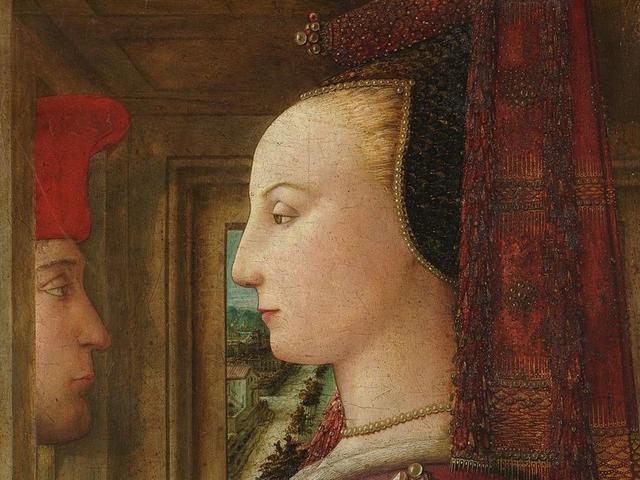Portrait of a woman with a man in a frame

This painting is considered important because it was made before couples regularly used portraits to commemorate their weddings, marriages, or the birth of children. It may be the first painting of its kind in existence. Prior to this work, portraits of the wealthy were usually made by incorporating their likeness into historical or biblical work.
Portrait of a Woman with a Man in a Frame is the first surviving double portrait in Italian art, depicting an engaged couple. The woman is represented in all her sumptuous beauty, dressed in the finest textiles and jewelry. Her husband leans against the window, and although the coat of arms under his hands cannot be definitively identified, it is likely to be that of the Scolari family of Florence. The couple, then, is Ranieri Scolari and Angiola di Bernardo Sapiti, who married in 1436.
Depicting the details of textiles and jewelry, this image documents the elaborate dress of a newlywed bride in Renaissance Italy. Her red overdress is lined in fur, her dark sleeve under the dress embroidered in gold. Pearls adorn her sella (headdress), and also appear in abundance around the cuff of her dress, arranged to form the word lealtà (loyalty).
Lippi's innovations suggest an intention to create a visual analogue to the concepts of Petrarchan poetry. The image affirms the portrait as a poetic evocation rather than a mere commemoration of a betrothal, marriage, or birth; an idealized representation rather than a record of the attendees' actual appearance.
The author Filippo Lippi was born (c. 1406, Florence; died October 1469, Spoleto) into a very large and poor family in Florence. After the death of his father and mother, young Filippo was raised by an aunt for some years; He later placed him with his brother in the convent of Carmelite monks in Santa Maria del Carmine. The Brancacci chapel of the monastery was decorated with frescoes by Masaccio. These frescoes, which must have been among the most glorious and influential paintings of the Renaissance, were Lippi's first important contact with art.
© Tourblink